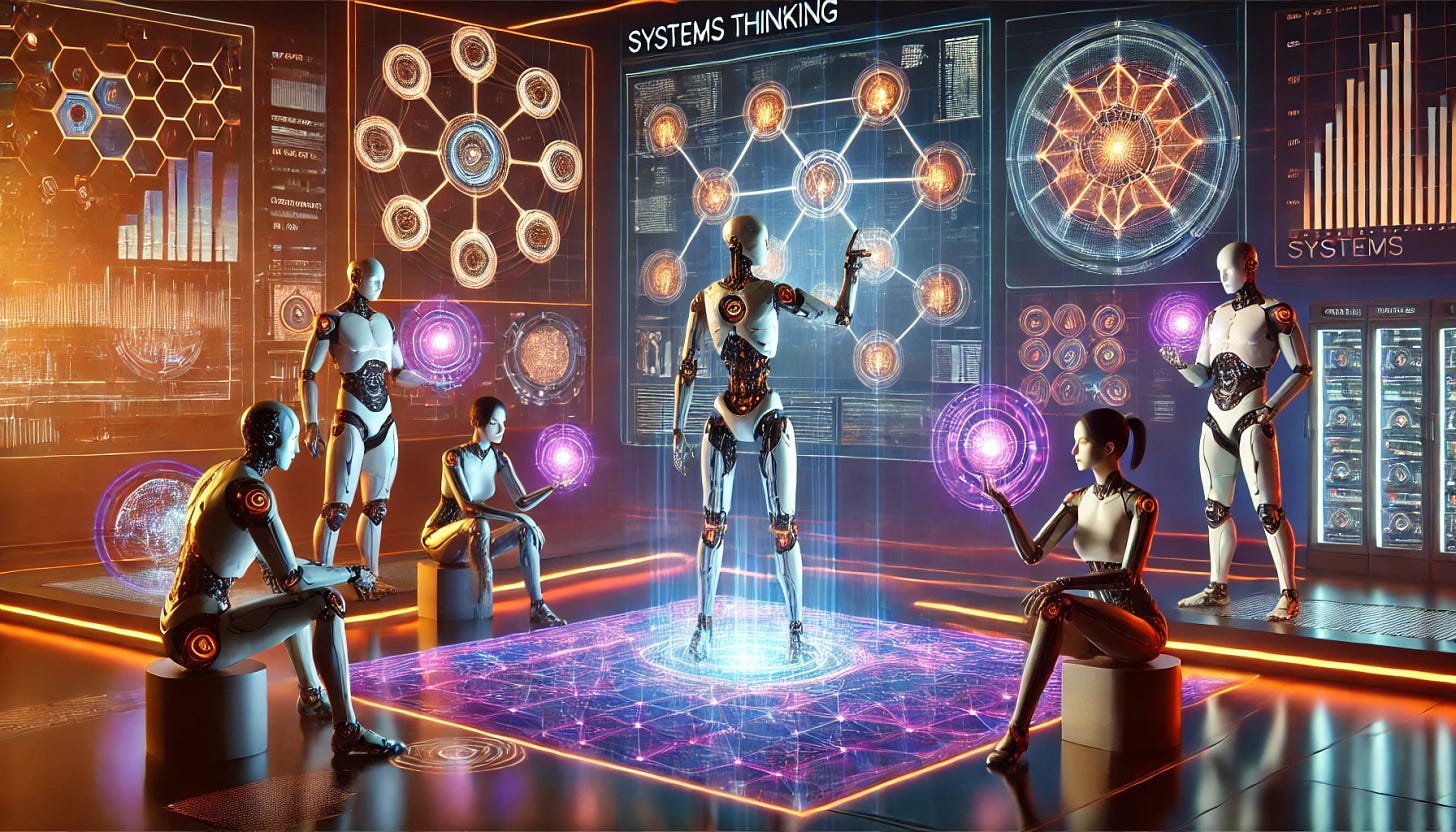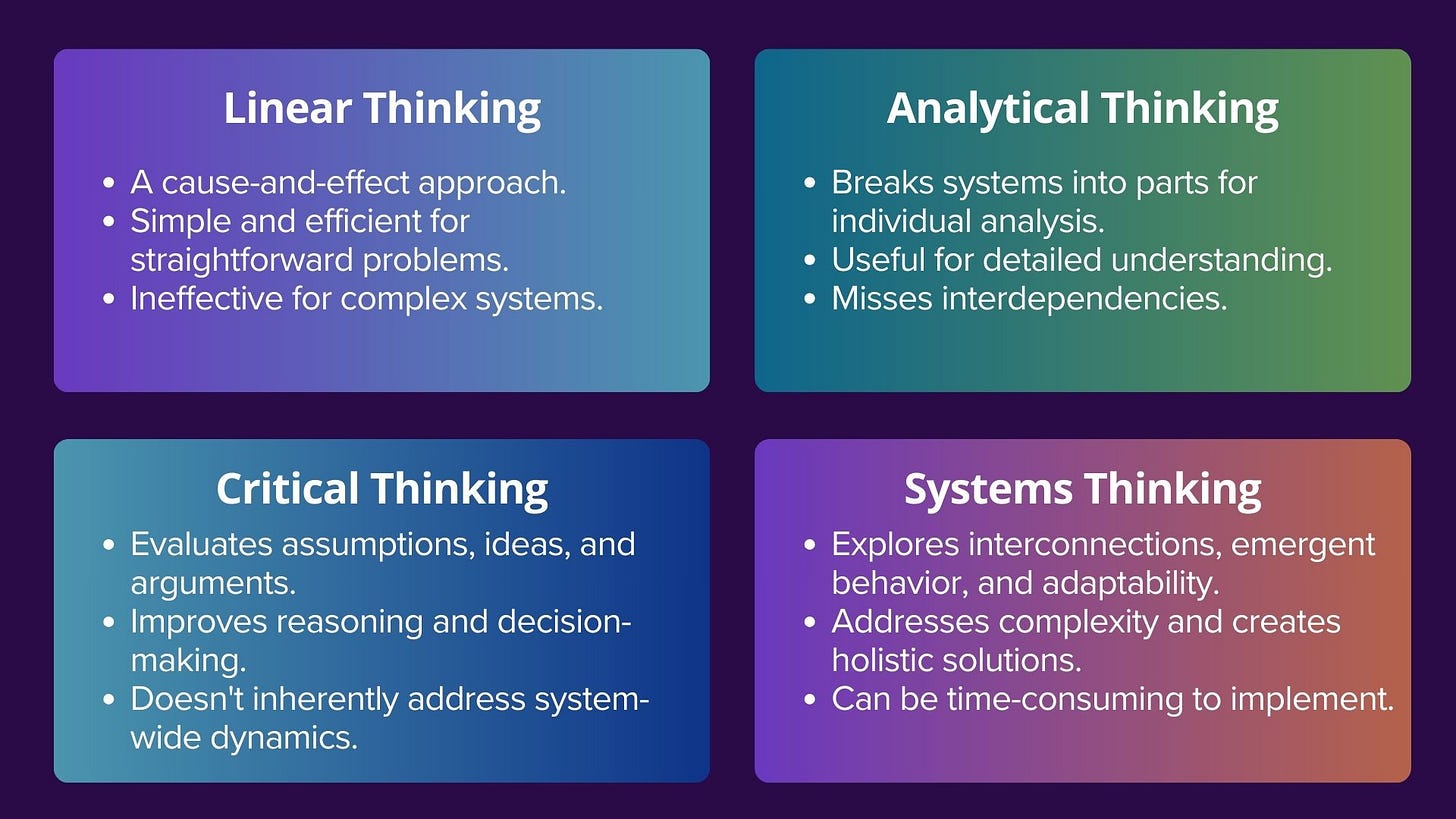Embracing Systems Thinking in an Interconnected Future
Thinking differently for a socio technical system of the future
We live in a universe of systems. From the vast expanse of galaxies orbiting each other to the intricate processes within a single cell, systems define the fabric of existence. At its core, a system is a collection of interconnected components that interact to form a cohesive whole, where the behavior of the whole is more than just the sum of its parts. This article explores what systems thinking is, and how it differs from traditional approaches, why it is indispensable for managing complexity, and how it prepares us for the socio-technical landscapes of the future.
This principle of interconnectedness extends beyond nature to the human-made world. Societies themselves are complex systems, where social, cultural, and economic components interact to create distinct civilizations. Over time, humanity has added another layer to this complexity: technology. From early tools to modern AI, technology is not just a tool but a transformative force that reshapes the systems it integrates with.
Socio-Technical Systems: The Nexus of Humans and Technology
A socio-technical system is an intricate network where human, technological, and organizational elements coexist, interact, and evolve together. These systems are the backbone of modern society, encompassing everything from global supply chains and healthcare networks to digital communication platforms and transportation infrastructures. Their complexity arises not just from the sheer number of components but also from the dynamic interdependencies between human behaviours, cultural contexts, technological capabilities, and policy frameworks.
Socio-technical systems thrive on interaction and adaptability, making them uniquely suited to systems thinking. This approach ensures we don't just optimize individual components but design for the resilience, sustainability, and ethical alignment of the entire system. As we face global challenges like climate change, resource management, and rapid technological advancements, systems thinking equips us to navigate these complexities effectively.
Understanding Systems Thinking
Systems thinking is a holistic approach that examines the interplay between the components of a system, emphasizing relationships, interdependencies, and feedback loops. Instead of focusing solely on isolated elements, systems thinking views the system as a whole, appreciating how its parts interact dynamically.
Key Characteristics of Systems Thinking:
Focus on Interdependencies: Systems thinking prioritizes the connections between parts, understanding how changes in one area influence others.
Non-Linear Analysis: It acknowledges that outcomes often result from complex interactions rather than simple cause-effect relationships.
Feedback Loops: Central to systems thinking, feedback loops illustrate how outputs of a system can loop back as inputs, influencing future behavior.
How Systems Thinking Differs from Other Modes of Thinking
Early human efforts to create socio-technical systems relied heavily on linear thinking—a straightforward cause-and-effect approach. This mode was invaluable in building the foundational components of technology and infrastructure, such as the invention of the wheel, the design of simple machinery, and early engineering marvels like aqueducts.
As systems grew more sophisticated, analytical thinking emerged as a powerful tool. By breaking systems into individual components for in-depth analysis, humanity could optimize specific parts—leading to significant advancements in technology, medicine, and engineering. For example, dissecting production processes during the Industrial Revolution revolutionized manufacturing efficiency.
With the rapid growth of technology and its societal implications, critical thinking became essential for assessing ideas, challenging assumptions, and ensuring ethical considerations. As socio-technical systems have become increasingly complex and interdependent, systems thinking has emerged as the most effective framework for understanding and managing them.
By focusing on interconnections, feedback loops, and emergent behaviours, systems thinking addresses the inherent complexity of socio-technical systems. In essence, systems thinking complements other approaches by offering a macro view—a crucial skill in a world of increasing complexity and interconnectivity, a massive global socio-technical system.
Why Systems Thinking Matters for the Future
As humanity ventures into uncharted territories—space exploration, AI integration, and global challenges—systems thinking offers a roadmap. It helps us:
Design socio-technical systems that adapt to uncertainty.
Leverage technological force multipliers responsibly.
Foster global collaboration by aligning diverse stakeholders around shared goals.
By adopting systems thinking, we align ourselves with the intricacies of modern systems, ensuring solutions that are not only effective but enduring. Understanding systems and their complexities is just the beginning. The true value of systems thinking lies in its ability to translate understanding into impactful action. Here's how to do it:
Think Big
Adopt a macro view to grasp the full scope of a system. Visualize the interconnected parts, feedback loops, and potential ripple effects. For example, tackling climate change requires global perspectives on policy, technology, and cultural shifts.
Act Small
Break down large, complex goals into actionable steps. Pilot small-scale interventions to test ideas within the system before scaling up. In healthcare, for instance, localized telemedicine solutions can address specific communities' needs while gathering data for broader application.
Channel the Medium
Communication is the bridge between thought and action. In today’s interconnected world, the medium through which we communicate is as vital as the message itself. Identifying the right medium for transmitting information ensures clarity and alignment.
As we explore the complexities of systems thinking and its role in shaping the socio-technical landscapes of tomorrow, the power of connection cannot be overstated. The goal is not just to inform but to inspire collective action and curiosity, empowering us to think big, act small, and channel our shared medium of connection to make a lasting impact.
This newsletter, along with my presence on Substack and other platforms, serves as a medium to bridge ideas and action, fostering a community of thinkers, dreamers, and doers—the Observer Family. So, follow along my journey and let’s connect, collaborate and communicate.
Until next time, keep observing, learning, and thinking systemically.







First of all, congratulations on your publication. I am very interested in complex systems and, therefore, in system thinking. I wanted to ask if you could recommend some key reference books that you consider essential for understanding and exploring this topic further. Thank you!